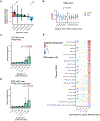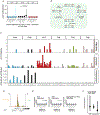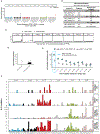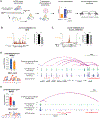Somatic mosaicism in schizophrenia brains reveals prenatal mutational processes
- PMID: 39388546
- PMCID: PMC11490355
- DOI: 10.1126/science.adq1456
Somatic mosaicism in schizophrenia brains reveals prenatal mutational processes
Abstract
Germline mutations modulate the risk of developing schizophrenia (SCZ). Much less is known about the role of mosaic somatic mutations in the context of SCZ. Deep (239×) whole-genome sequencing (WGS) of brain neurons from 61 SCZ cases and 25 controls postmortem identified mutations occurring during prenatal neurogenesis. SCZ cases showed increased somatic variants in open chromatin, with increased mosaic CpG transversions (CpG>GpG) and T>G mutations at transcription factor binding sites (TFBSs) overlapping open chromatin, a result not seen in controls. Some of these variants alter gene expression, including SCZ risk genes and genes involved in neurodevelopment. Although these mutational processes can reflect a difference in factors indirectly involved in disease, increased somatic mutations at developmental TFBSs could also potentially contribute to SCZ.
Conflict of interest statement
Figures





Similar articles
-
Building a schizophrenia genetic network: transcription factor 4 regulates genes involved in neuronal development and schizophrenia risk.Hum Mol Genet. 2018 Sep 15;27(18):3246-3256. doi: 10.1093/hmg/ddy222. Hum Mol Genet. 2018. PMID: 29905862 Free PMC article.
-
Low-Level Brain Somatic Mutations Are Implicated in Schizophrenia.Biol Psychiatry. 2021 Jul 1;90(1):35-46. doi: 10.1016/j.biopsych.2021.01.014. Epub 2021 Feb 5. Biol Psychiatry. 2021. PMID: 33867114
-
Genes regulated by BCL11B during T-cell development are enriched for de novo mutations found in schizophrenia patients.Am J Med Genet B Neuropsychiatr Genet. 2020 Sep;183(6):370-379. doi: 10.1002/ajmg.b.32811. Epub 2020 Jul 29. Am J Med Genet B Neuropsychiatr Genet. 2020. PMID: 32729240
-
Somatic Mosaicism and Autism Spectrum Disorder.Genes (Basel). 2021 Oct 26;12(11):1699. doi: 10.3390/genes12111699. Genes (Basel). 2021. PMID: 34828306 Free PMC article. Review.
-
Intersection of diverse neuronal genomes and neuropsychiatric disease: The Brain Somatic Mosaicism Network.Science. 2017 Apr 28;356(6336):eaal1641. doi: 10.1126/science.aal1641. Epub 2017 Apr 27. Science. 2017. PMID: 28450582 Free PMC article. Review.
References
MeSH terms
Substances
Grants and funding
- R01 MH123155/MH/NIMH NIH HHS/United States
- U01 MH106883/MH/NIMH NIH HHS/United States
- T15 LM007092/LM/NLM NIH HHS/United States
- R01 MH125579/MH/NIMH NIH HHS/United States
- DP2 AG072437/AG/NIA NIH HHS/United States
- U01 HG012009/HG/NHGRI NIH HHS/United States
- U01 MH106876/MH/NIMH NIH HHS/United States
- R01 MH106056/MH/NIMH NIH HHS/United States
- R00 HG010669/HG/NHGRI NIH HHS/United States
- R35 GM127131/GM/NIGMS NIH HHS/United States
- K01 AG051791/AG/NIA NIH HHS/United States
- HHMI/Howard Hughes Medical Institute/United States
- T32 GM007753/GM/NIGMS NIH HHS/United States
- U01 MH106891/MH/NIMH NIH HHS/United States
- R01 MH131623/MH/NIMH NIH HHS/United States
- R01 HG012872/HG/NHGRI NIH HHS/United States
- F31 MH124292/MH/NIMH NIH HHS/United States
- R01 MH101244/MH/NIMH NIH HHS/United States
LinkOut - more resources
Full Text Sources
Medical

